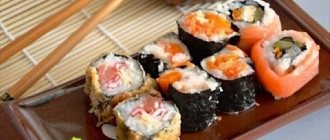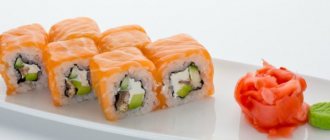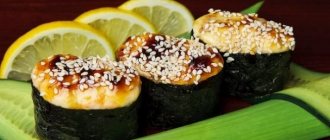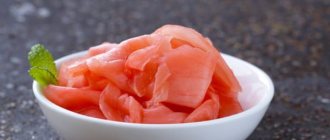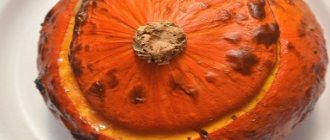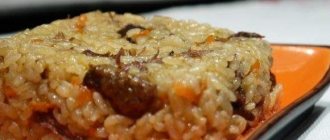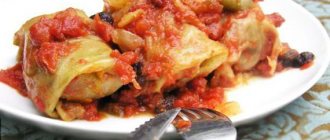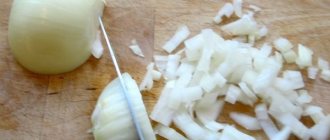Sushi and rolls are popular Japanese dishes that use polished short-grain rice. Cooking rice seems simple, but it is not always possible to replicate it at home. The secret lies in the correct choice of temperature and duration of heat treatment. Knowing these features, you will quickly figure out how to cook rice for sushi and rolls at home.
The right rice for sushi: choose in the store
The Japanese themselves call the rice used for sushi Hakumai - it is a white grain with short rounded grains, with the rough outer shell removed. It is what is used to prepare traditional Japanese dishes at home: it remains quite sticky without turning into porridge.
The most common brands of sushi rice in stores are:
- Sen Soy;
- SanBonsai;
- Bravolli;
- Ginshari;
- Riso Vignola;
- MIDORI.
In the packages of these manufacturers you can most often find varieties of koshi-higari and sushi, which are used to prepare sushi by the Japanese themselves.
When there is no rice of these brands in the store, then any round-grain product is suitable for sushi. The main thing is that it is unsteamed, of the highest quality - without cracks, without black inclusions. Sanded and unpolished grits are suitable. National brand products are quite suitable for these purposes.
Japanese rice is the perfect choice
The National brand offers sushi lovers the Japanese rice variety, which is round white grains. Japanese rice has its own peculiarity: its grains have increased stickiness. Short grain white rice is part of Japan's national culture. Feel this vibrant and amazing country with real Japanese rice. The most important thing is that it has no aroma. This is an important criterion for choosing rice for Japanese cuisine. Soft white rice is the basis of most Japanese dishes, which we also love, and is perfect for sushi, traditional gohan, chahan and other traditional dishes. Only this kind of rice will hold the shape of sushi and rolls. Long grain rice, which contains less starch, is not suitable for this dish as the sushi will fall apart. The same goes for steamed rice, which never sticks.
Short grain rice is part of the national cuisine of Japan. Rice grains should be whole, without chipped or broken grains. The cereal should be beautiful, without cracks or defects. Only white rice grains contain a sufficient amount of starch.
How much rice do you need?
It all depends on the number of rolls you intend to make. Sushi rice is prepared at home in small portions, boiling from 150 to 300 grams at a time. This makes it easier to maintain the technology and recipe. From 200 grams of rice you will get up to 500 g of finished product. The weight of one pack in the store varies from 250 to 800 grams.
It is better to cook fresh rice again if there is suddenly not enough of it, than to leave a large amount for later. He recommends making rolls from warm rice. Putting it in the refrigerator after cooking or storing it for a long time is not recommended.
Recipe for rice rolls with rice vinegar. Calorie, chemical composition and nutritional value.
Nutritional value and chemical composition of “Rice for rolls with rice vinegar.”
The table shows the nutritional content (calories, proteins, fats, carbohydrates, vitamins and minerals) per 100 grams of edible portion.
| Nutrient | Quantity | Norm** | % of the norm in 100 g | % of the norm in 100 kcal | 100% normal |
| Calorie content | 88 kcal | 1684 kcal | 5.2% | 5.9% | 1914 |
| Squirrels | 1.7 g | 76 g | 2.2% | 2.5% | 4471 g |
| Fats | 0.3 g | 56 g | 0.5% | 0.6% | 18667 |
| Carbohydrates | 19.9 g | 219 g | 9.1% | 10.3% | 1101 g |
| Alimentary fiber | 0.7 g | 20 g | 3.5% | 4% | 2857 g |
| Water | 77.1 g | 2273 g | 3.4% | 3.9% | 2948 g |
| Ash | 0.444 g | ~ | |||
| Vitamins | |||||
| Vitamin B1, thiamine | 0.019 mg | 1.5 mg | 1.3% | 1.5% | 7895 g |
| Vitamin B2, riboflavin | 0.009 mg | 1.8 mg | 0.5% | 0.6% | 20000 g |
| Vitamin B4, choline | 18.19 mg | 500 mg | 3.6% | 4.1% | 2749 g |
| Vitamin B5, pantothenic | 0.093 mg | 5 mg | 1.9% | 2.2% | 5376 g |
| Vitamin B6, pyridoxine | 0.047 mg | 2 mg | 2.4% | 2.7% | 4255 g |
| Vitamin B9, folates | 4.432 mcg | 400 mcg | 1.1% | 1.3% | 9025 g |
| Vitamin E, alpha tocopherol, TE | 0.093 mg | 15 mg | 0.6% | 0.7% | 16129 g |
| Vitamin H, biotin | 0.816 mcg | 50 mcg | 1.6% | 1.8% | 6127 g |
| Vitamin RR, NE | 0.7697 mg | 20 mg | 3.8% | 4.3% | 2598 g |
| Niacin | 0.373 mg | ~ | |||
| Macronutrients | |||||
| Potassium, K | 23.43 mg | 2500 mg | 0.9% | 1% | 10670 g |
| Calcium, Ca | 6.3 mg | 1000 mg | 0.6% | 0.7% | 15873 g |
| Silicon, Si | 23.326 mg | 30 mg | 77.8% | 88.4% | 129 g |
| Magnesium, Mg | 12.46 mg | 400 mg | 3.1% | 3.5% | 3210 g |
| Sodium, Na | 111.52 mg | 1300 mg | 8.6% | 9.8% | 1166 g |
| Sera, S | 11.97 mg | 1000 mg | 1.2% | 1.4% | 8354 g |
| Phosphorus, P | 35.2 mg | 800 mg | 4.4% | 5% | 2273 g |
| Chlorine, Cl | 173.44 mg | 2300 mg | 7.5% | 8.5% | 1326 g |
| Microelements | |||||
| Aluminium, Al | 212.7 mcg | ~ | |||
| Bor, B | 28 mcg | ~ | |||
| Vanadium, V | 34.99 mcg | ~ | |||
| Iron, Fe | 0.25 mg | 18 mg | 1.4% | 1.6% | 7200 g |
| Yod, I | 0.33 mcg | 150 mcg | 0.2% | 0.2% | 45455 g |
| Cobalt, Co | 0.275 mcg | 10 mcg | 2.8% | 3.2% | 3636 g |
| Lithium, Li | 1.166 mcg | ~ | |||
| Manganese, Mn | 0.2936 mg | 2 mg | 14.7% | 16.7% | 681 g |
| Copper, Cu | 59.52 mcg | 1000 mcg | 6% | 6.8% | 1680 g |
| Molybdenum, Mo | 2.278 mcg | 70 mcg | 3.3% | 3.8% | 3073 g |
| Nickel, Ni | 0.63 mcg | ~ | |||
| Rubidium, Rb | 0.7 mcg | ~ | |||
| Selenium, Se | 3.523 mcg | 55 mcg | 6.4% | 7.3% | 1561 g |
| Strontium, Sr | 0.59 mcg | ~ | |||
| Titanium, Ti | 4.67 mcg | ~ | |||
| Fluorine, F | 85.27 mcg | 4000 mcg | 2.1% | 2.4% | 4691 g |
| Chromium, Cr | 0.4 mcg | 50 mcg | 0.8% | 0.9% | 12500 g |
| Zinc, Zn | 0.3329 mg | 12 mg | 2.8% | 3.2% | 3605 g |
| Zirconium, Zr | 2.05 mcg | ~ | |||
| Digestible carbohydrates | |||||
| Starch and dextrins | 17.004 g | ~ | |||
| Mono- and disaccharides (sugars) | 2.7 g | max 100 g | |||
| Glucose (dextrose) | 0.021 g | ~ | |||
| Maltose | 0.04 g | ~ | |||
| Sucrose | 0.091 g | ~ | |||
| Fructose | 0.017 g | ~ | |||
| Essential amino acids | |||||
| Arginine* | 0.119 g | ~ | |||
| Valin | 0.098 g | ~ | |||
| Histidine* | 0.04 g | ~ | |||
| Isoleucine | 0.077 g | ~ | |||
| Leucine | 0.145 g | ~ | |||
| Lysine | 0.061 g | ~ | |||
| Methionine | 0.037 g | ~ | |||
| Methionine + Cysteine | 0.07 g | ~ | |||
| Threonine | 0.056 g | ~ | |||
| Tryptophan | 0.023 g | ~ | |||
| Phenylalanine | 0.087 g | ~ | |||
| Phenylalanine+Tyrosine | 0.154 g | ~ | |||
| Nonessential amino acids | |||||
| Alanin | 0.091 g | ~ | |||
| Aspartic acid | 0.126 g | ~ | |||
| Glycine | 0.075 g | ~ | |||
| Glutamic acid | 0.28 g | ~ | |||
| Proline | 0.077 g | ~ | |||
| Serin | 0.077 g | ~ | |||
| Tyrosine | 0.068 g | ~ | |||
| Cysteine | 0.033 g | ~ | |||
| Sterols (sterols) | |||||
| beta sitosterol | 4.665 mg | ~ | |||
| Saturated fatty acids | |||||
| Saturated fatty acids | 0.1 g | max 18.7 g | |||
| 14:0 Miristinovaya | 0.003 g | ~ | |||
| 16:0 Palmitinaya | 0.042 g | ~ | |||
| 18:0 Stearic | 0.009 g | ~ | |||
| Monounsaturated fatty acids | 0.075 g | min 16.8 g | 0.4% | 0.5% | |
| 18:1 Oleic (omega-9) | 0.075 g | ~ | |||
| Polyunsaturated fatty acids | 0.045 g | from 11.2 to 20.6 g | 0.4% | 0.5% | |
| 18:2 Linolevaya | 0.045 g | ~ |
The energy value of Rice for rolls with rice vinegar is 88 kcal.
Primary Source: Created in the application by the user. Read more.
** This table shows the average levels of vitamins and minerals for an adult. If you want to know the norms taking into account your gender, age and other factors, then use the “My Healthy Diet” application.
Preparing sushi rice
To prepare sushi rice at home, you will need not only special ingredients, but also special utensils. Prepare in advance:
- A thick-bottomed pan, such as cast iron;
- A deep bowl and a colander to rinse the rice well;
- A wooden cutting board or a large bowl, wooden is key here;
- A saucepan to mix and heat the dressing;
- Kitchen scales and measuring cups;
- The stirring spatula is not a spoon.
When the workplace and the necessary tools are prepared, you can begin the process itself.
Sushi rice: homemade recipe
The exact proportions depend on the specific recipe. Therefore, read the recommendations carefully. In our recipe, rice for rolls is taken at the rate of 250 grams of cereal per serving. Refueling is calculated for the same amount.
It is important to understand that a glass with a volume of 250 ml does not mean that 250 grams of rice will fit into it. We measure bulk products on scales, and water in milliliters. Then you will get exact proportions without errors.
The measured portion of rice should be rinsed under water. A colander and a deep bowl will help you easily cope with the task. Rinse until the water runs clear. Those grains that will float up should be removed, rather than trying to catch them and leave them in the cup. After washing, you need to let the rice drain and add fresh water. Then leave to soak for 15-20 minutes.
How to cook sushi rice?
Place the rice, from which the water has previously been drained, into the prepared pan. Just now add the water measured in advance and put it on the fire. For flavor, add a piece of dried nori to the rice. Just before boiling, the algae must be removed, and as soon as the water boils, set the power of the stove to minimum. In this mode, rice cooks for up to 12 minutes. The water should boil away and the rice should not stick to the bottom.
Turn off the heat, cover with a lid, and leave on the stove for 15 minutes until the rice finishes cooking.
How to prepare sushi rice at home
Transfer the steeped rice from the pan into a wooden cup; if you don’t have one, then place it on a wooden cutting board. Use a spatula for this. After this, carefully pour the dressing over the rice, while stirring with a spatula.
It is very important that the dressing is evenly distributed over the rice, and that the rice does not turn into porridge during the stirring process. A wooden cup or board is needed so that excess sauce is absorbed into the wood and does not oversaturate the cereal.
Rice should be seasoned when it is moderately warm. If the rice is too hot, the dressing will evaporate and you will not be able to achieve the rich taste and aroma. And if the rice cools too much, the grains will not be able to absorb the dressing.
How to prepare a dressing for rice with vinegar?
Vinegar dressing is an integral part of any rolls. It gives the rice a special sourness and gives it a pleasant aroma, adding the finishing touch to the preparation of this part of the dish. To prepare this dressing (for 450 grams of rice) you will need:
- Rice vinegar 2 tbsp. l.,
- 1 tsp. Sahara,
- 1 tsp. salt.
Pour the vinegar into a small container and put it on the fire. Very important: the fire should be minimal so that our dressing does not boil. After this, add salt and sugar to the vinegar, stir gently until they dissolve. Then remove the mixture from the heat, let it cool slightly and sprinkle it over the boiled rice. Remember that you need to stir the rice very carefully to maintain its integrity and not turn it into porridge.
There is another recipe for making vinegar dressing. The number of ingredients remains the same, but one more component is added to the composition - algae. To prepare it you need:
- Rice vinegar 2 tbsp. l.,
- 1 tsp. salt,
- 1 tsp. Sahara,
- Seaweed Kombu (Nori) 3 gr.
The process of preparing such a dressing is practically the same. We also put the vinegar on low heat, add the rest of the ingredients and stir until the salt and sugar dissolve. The difference is that before you remove our dressing from the heat, you need to remove the seaweed. They have already given everything they need to the sauce and are no longer needed. Now wait for the sauce to cool and add it to the rice. Now our rice is completely ready!
Rice dressing
To cook sushi rice at home and get the same tasty product as in Sushi WOK, you need to prepare a dressing. Mix everything while the rice arrives. The calculation of the products that we take for cooking depends on the amount of rice that we will season. In our case, it is 500 grams.
For this volume you need:
- 25 rice and 25 white wine vinegar, you can only use rice vinegar;
- 25 grams of sugar;
- Half a teaspoon of salt, you can take sea salt.
Mix all ingredients in a saucepan and heat until dissolved. No need to boil! After this, the mixture should cool slightly.
Choosing the right rice is the key to good results
On supermarket shelves you can find rice from dozens of manufacturers and cereals of various varieties, so you need to pay attention to choosing it wisely. To prevent the rolls from falling apart, it is recommended to look at the following when purchasing:
- For the type of rice. The best options are white rice and short grain rice. These types of cereals, unlike brown rice, have a high gluten content, which is ensured by the presence of starch in it. Gluten is released during cooking, making the rolls strong and solid, they will not fall apart;
- On the purity of the product. There should be no husks or dark spots on the rice; rice for rolls should be chosen by color - pure white would be ideal, while the grains should be opaque.
After purchasing, you need to take care of proper storage of the product before using it in cooking. It is best to keep rice in a closed package, away from high humidity.
Professionals recommend spending money and buying Japanese rice, also called “nishiki,” especially for rolls. It should not be steamed, this also applies to other varieties, since otherwise the amount of starch in the composition will not be enough for normal gluing of grains, the rolls will not hold their shape and will fall apart when you try to pick them up with a stick. Pay attention to the calorie content - rice for rolls at home should have as many calories as possible. Take several packs of rice in the store, compare them by calorie content, not forgetting about the characteristics of the variety indicated above, buy the pack with the maximum calorie content. But, if you just want to eat rolls, you shouldn’t spend so much time looking for the right rice, it’s easier to order a ready-made dish, it will definitely have the right type of rice.
How to cook rice for rolls in a slow cooker
Many housewives probably already have a miracle saucepan, but not many know how to cook rice for rolls in a slow cooker. And cooking it is even easier than over a fire, now see for yourself.
- The proportions for cooking rice in a multicooker remain the same as when cooking it in a saucepan.
- After thoroughly washing the rice, we simply put the cereal in the multicooker bowl, fill it with water and turn on the “fast” or “buckwheat” mode. The “buckwheat” mode is more suitable for special Japanese rice.
- Next, the rice is simply placed in a large bowl and poured with a mixture of rice vinegar, sugar and salt.
How long to cook rice for rolls - is there an exact time?
Surely many of us, before preparing the dish, wondered how long to cook rice for rolls and is there an exact cooking time?
Unfortunately, no recipe can guarantee the preparation of perfect rice for rolls at the exact time.
This is because different rices require different times. For example, most special varieties of Japanese rice indicate a cooking time of 30-40 minutes, and ordinary round-grain rice, which already cooks perfectly, needs to be cooked for 15 minutes after boiling.
Therefore, when you buy special rice, pay attention to what recommendations are indicated on the package. But most likely such problems can arise only the first time you cook rice.
Then you yourself will find that golden mean when the rice comes out exactly as required for preparing the rolls! Good luck to you, you will definitely succeed!
How to cook rice for rolls in a double boiler
Now we’ll tell you how to cook rice for rolls in a double boiler.
- To cook rice, it is enough to take 1.5-2 cups of water for 1 cup of rice.
- Fill the washed rice with water and simply set the timer.
- For rice rolls, 25 minutes should be enough.
- But you can first try cooking for 20 minutes, and if the water is not absorbed and the rice is hard, then turn on the steamer again.
